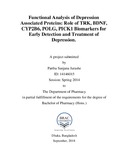| dc.contributor.advisor | Siam, Mohammad Kawsar Sharif | |
| dc.contributor.author | Jurashe, Partha Sanjana | |
| dc.date.accessioned | 2019-03-21T04:26:44Z | |
| dc.date.available | 2019-03-21T04:26:44Z | |
| dc.date.copyright | 2018 | |
| dc.date.issued | 2018-09 | |
| dc.identifier.other | ID 14146015 | |
| dc.identifier.uri | http://hdl.handle.net/10361/11608 | |
| dc.description | This project report is submitted in partial fulfilment of the requirements for the degree of Bachelor of Pharmacy, 2018. | en_US |
| dc.description | Catalogued from PDF version of project report. | |
| dc.description | Includes bibliographical references (pages 36-45). | |
| dc.description.abstract | Psychiatric diseases relentlessly distress the ability of work also productivity of a person’s
life. Considering the phenotypic unpredictability amongst patients, it is very hard to
understand the pathogenesis. The study aims to identify the pathways responsible for
psychiatric disease, especially for depression. Initially 62 depression associated proteins were
listed from the UniProt and then hub genes of those proteins were identified. For functional
annotation analysis, proteins UniProt IDs were submitted to the Database for Annotation,
Visualization and Integrated Discovery shortly known as DAVID. Gene ontologies, protein
domains, and pathways were analyzed using the GO enrichment and KEGG. The functional
annotation clustering identified a total of 150 GO terms clustered into 23 groups. The
pathways, identified from the clustering and KEGG, were overlapped to construct a Protein
Protein Interaction (PPI) network. Finally, the common pathways were separated and 300
selected anti-depressants drugs from 5 classes were docked with depression associated
proteins such as iGluR DELTA-2 (PDB ID- 5KC8), Dopamine Receptor, D2 (PDB ID-
6CM4), Sodium Dependent Serotonin Transporter (PDB ID- 2KS9), Glutamate receptor
ionotropic, NMDA 2B (PDB ID- 5EWL) etc. Six anti-depressant drugs such as sertraline
carbamoyl, norethindrone, and aripiprazole had good binding affinities (-10.5, -10.4 and -9.3
respectively) with the proteins of interest. The study also revealed that biomarkers like, TRK,
BDNF, CYP2B6, POLG, PICK1 could be suitable for early detection of depression. Building
on these findings, studies could be designed to target and examine protein clusters to
understand depression and its transduction targets to identify functional biomarkers for early
diagnosis. | en_US |
| dc.description.statementofresponsibility | Partha Sanjana Jurashe | |
| dc.format.extent | 45 pages | |
| dc.language.iso | en | en_US |
| dc.publisher | BRAC University | en_US |
| dc.rights | BRAC University project reports are protected by copyright. They may be viewed from this source for any purpose, but reproduction or distribution in any format is prohibited without written permission. | |
| dc.subject | TRK | en_US |
| dc.subject | BDNF | en_US |
| dc.subject | CYP2B6 | en_US |
| dc.subject | POLG | en_US |
| dc.subject | PICK1 Biomarkers | en_US |
| dc.subject | Depression | en_US |
| dc.subject.lcsh | Affective disorders | |
| dc.title | Functional analysis of depression associated proteins: role of TRK, BDNF, CYP2B6, POLG, PICK1 Biomarkers for early detection and treatment of depression | en_US |
| dc.type | Project report | en_US |
| dc.contributor.department | Department of Pharmacy, BRAC University | |
| dc.description.degree | B. Pharmacy | |

